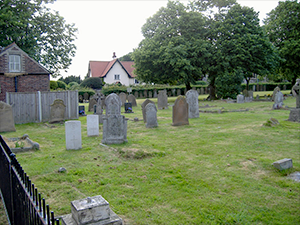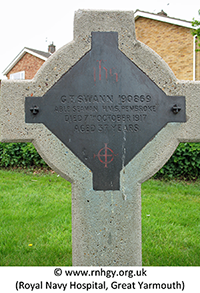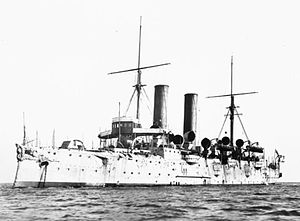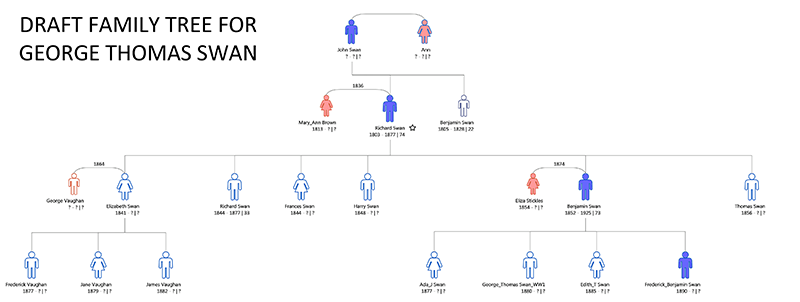First World War Project
George Thomas SWAN (of Teynham)
b. 3rd October 1880 Able Seaman, Service Number 190869(CH) |

 We know precious little about the man who was George Thomas Swan. Benjamin and Eliza (née Stickles) Swan raised a family of four children - Ada J, George Thomas, Edith T, and Frederick Benjamin. While George's father was born in Wye, Kent, most of his and earlier generations were natives of Boughton Aluph. His wife, Eliza was born in Godmersham, as was George. George's sisters and brother were born in Selling.
We know precious little about the man who was George Thomas Swan. Benjamin and Eliza (née Stickles) Swan raised a family of four children - Ada J, George Thomas, Edith T, and Frederick Benjamin. While George's father was born in Wye, Kent, most of his and earlier generations were natives of Boughton Aluph. His wife, Eliza was born in Godmersham, as was George. George's sisters and brother were born in Selling.
From 1901, the parental home was established at No.9 Station Row, Teynham. By 1911, George's brother Frederick, who was employed as a brick moulder, was the last of their children still living in the family home. This address is also referenced by the Commonwealth War Graves Commission records.
George died at Great Yarmouth Naval Hospital, and was buried in Caister-on-Sea Old Cemetery along with 11 other CWGC burials. This was the regular burial place from this Naval Hospital.
His mother, Eliza, was named as George's next of kin and would have received his medals and effects. [Appendix 2 - gratuity calculations]
| Faversham and North East Kent News of 17th November 1917 |
| SEAMAN G.T. SWAN, ROYAL NAVY. Seaman George Thomas Swan, son of Mr. and Mrs Benjamin Swann, of 9, Station Row, has died under sad circumstances after 21 years' naval service. He had seen a lot of naval war service, including operations in the Persian Gulf. Then he had a serious attack of sunstroke, upon which mental trouble followed. He died recently in hospital at Yarmouth. Deceased was a single man and 37 years of age. |
Military Experience of George Thomas Swan
George fixed his future with the Royal Navy quite early on. He appears in this connection in the Census returns for 1901 and 1911. So, at the very least, he served for 16 years before his untimely death through disease.
The suffix of (Ch) to his Service Number confirms that George enlisted at Chatham into the shore side base "HMS Pembroke 1" for training.
 In 1901, George appears as an able seaman, enumerated in Grand Harbour, Valletta, Malta. Here he was serving in "HMS Ramillies" and Tender "HMS Boxer", Torpedo Boat Destroyer. The "Ramillies" was a Sovereign Class pre-dreadnought Battleship laid down in 1890. In 1901 the ship fell under the command of Captain Robert S. Lowry. In the Mediterranean, the Ramillies acted as the flagship. After returning to Britain for refitting in 1903 she served in the Home Fleet. The ship was broken up in 1913, so never saw action in WW1.
In 1901, George appears as an able seaman, enumerated in Grand Harbour, Valletta, Malta. Here he was serving in "HMS Ramillies" and Tender "HMS Boxer", Torpedo Boat Destroyer. The "Ramillies" was a Sovereign Class pre-dreadnought Battleship laid down in 1890. In 1901 the ship fell under the command of Captain Robert S. Lowry. In the Mediterranean, the Ramillies acted as the flagship. After returning to Britain for refitting in 1903 she served in the Home Fleet. The ship was broken up in 1913, so never saw action in WW1.
Ten years later, the Census of 1911 records George with the rank of Leading Seaman in port at Felixstowe (Harwich Harbour), Suffolk, aboard HMS "Blenheim" described as a "Twin Screw Protected Cruiser, 1st Class - Depot Ship for First Destroyer Flotilla." George was at that time serving under Captain Douglas L. Dent, R.N., in the Home Fleet. The Blenheim began life in 1890 but by 1911 it had been converted to a depot ship (1907) and later was active in the Mediterranean where it won Battle Honours in the Dardanelles action (1915/1916).
What we have not been able to confirm is how long George remained with "HMS Blenheim" after 1911. Nor are we able to determine when he was put under medical care for his ultimately fatal illness.
Circumstances of the death of George Thomas Swan
George T Swan (sometimes SWANN), Able Seaman, "died from disease" and was buried at Caister, near Great Yarmouth. George's disease is recorded as "Dementia Paralytica" (Mental Paresis). The diagnosis of mental paresis was usually (but not exclusively) associated with late-stage syphilis. From the local newspaper report (above), it seems that George suffered mental collapse following serious sunstroke. The Royal Naval Hospital in Great Yarmouth served as a naval psychiatric unit throughout the First World War also treating other naval injuries and illness as appropriate.
Those who died from syphilis experience madness followed by death; syphilis could take several years to manifest. The patients passed through several stages of erratic behaviour and physical symptoms until the infection overcame the body. There was no effective treatment for syphilis, although attempts might include the use of mercury, but with no proven efficacy.
We are grateful to the Royal Navy Hospital, Great Yarmouth historical researchers for their permission to use the image of George's grave marker.
Serving from the outbreak of war, George Thomas Swan was awarded the posthumous Star, Victory and British War Medals. [See Appendix 1]



 World War 1 Pages
World War 1 Pages